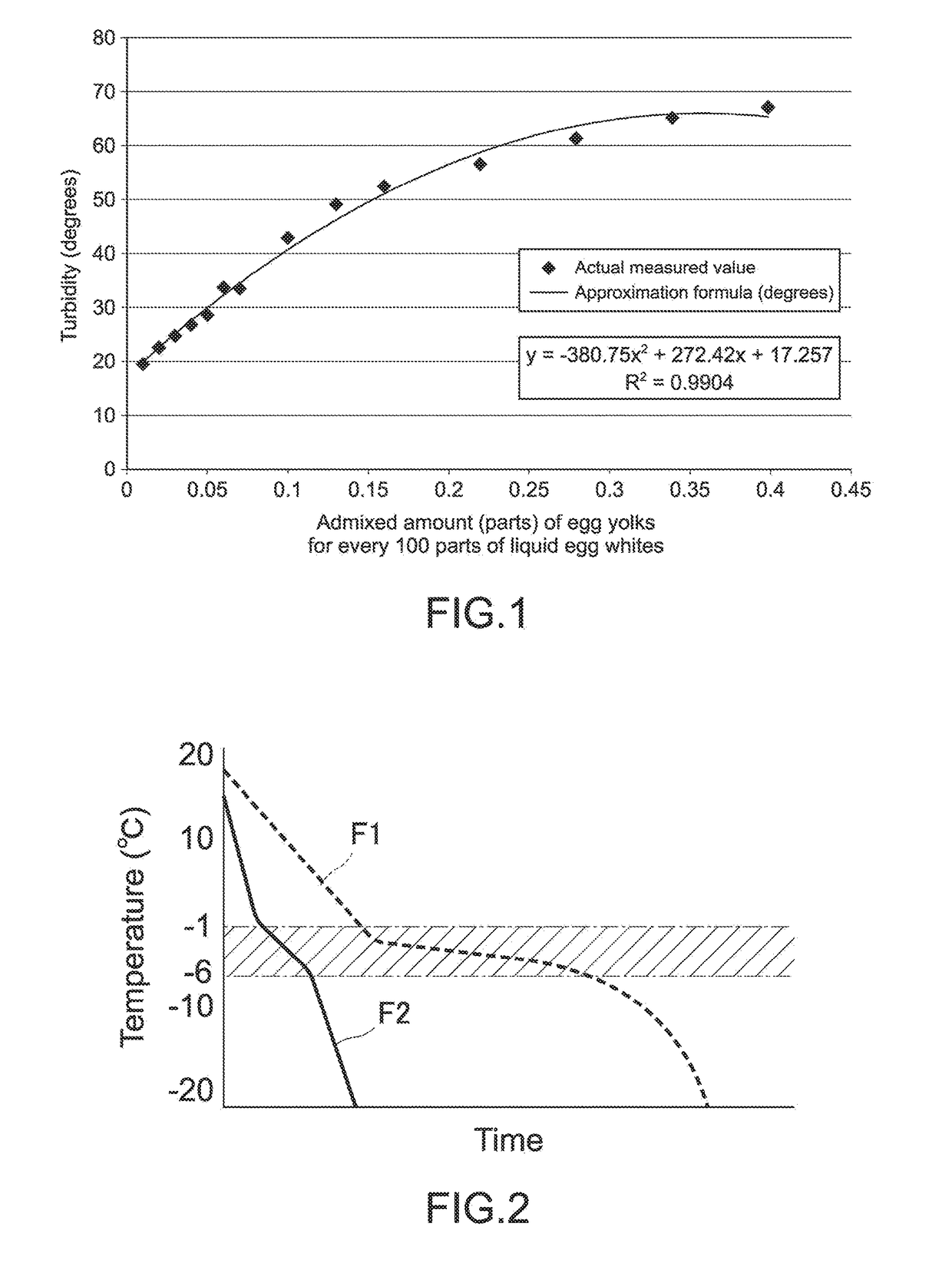Frozen Liquid Egg Whites, Method for Producing Same, and Liquid Egg Whites Resulting From Defrosting Frozen Liquid Egg Whites
- Summary
- Abstract
- Description
- Claims
- Application Information
AI Technical Summary
Benefits of technology
Problems solved by technology
Method used
Image
Examples
examples 1 to 3
[0098](Production of Frozen Liquid Egg Whites)
[0099]Shell eggs were broken mechanically, liquid egg whites were separated, the liquid egg whites were filtered and homogenized by using common methods, and raw-material liquid egg whites, in which egg yolks are admixed, were thus obtained. α-cyclodextrin of each added amount shown in Table 2 was added to the raw-material liquid egg whites, the raw-material liquid egg whites were stirred and mixed by using a stirring machine until being uniformly mixed, and liquid egg whites-with-additive were thus obtained. Further, the liquid egg whites-with-additive were heat-sterilized at 56° C. for 3.5 minutes by using a plate-type heat exchanger, and were packaged. Consequently, the liquid egg whites-with-additive were frozen to reach −18° C. or less, the transit time of the product-center temperature from −1° C. to −6° C. being 20 to 30 hours as shown in Table 2, and frozen liquid egg whites of Examples 1 to 3 were thus obtained. Table 2 further ...
example 4
[0109]Frozen liquid egg whites were produced similar to the frozen liquid egg whites of Example 1 except that the added amount of α-cyclodextrin was 0.5 parts. Consequently, similar to the frozen liquid egg whites of Examples 1 to 3, the turbidity was measured and calculated, and the turbidity change rate was calculated. The turbidity H2 was 85 degrees, the turbidity H3 (y) was 30 degrees, and the turbidity H1 was therefore 55 degrees according to the formula (1). Further, the turbidity measured after being refrigerated for 5 days was 84 degrees, the turbidity H4 was 54 degrees, and turbidity change rate h was therefore 97% according to the formula (3). Further, the ratio of the added amount of α-cyclodextrin to the admixed amount of egg yolks was 10.
example 5
[0110]Frozen liquid egg whites were produced similar to the frozen liquid egg whites of Example 1 except that the added amount of α-cyclodextrin was 1 part and that transit time of a product-center temperature from −1° C. to −6° C. was 15 hours. Consequently, similar to the frozen liquid egg whites of Examples 1 to 3, the turbidity was measured and calculated, and the turbidity change rate was calculated. The turbidity H2 was 89 degrees, the turbidity H3 (y) was 30 degrees, and the turbidity H1 was therefore 59 degrees according to the formula (1). Further, the turbidity measured after being refrigerated for 5 days was 88 degrees, the turbidity H4 was 58 degrees, and turbidity change rate h was therefore 99% according to the formula (3). Further, the ratio of the added amount of α-cyclodextrin to the admixed amount of egg yolks was 20.
PUM
 Login to View More
Login to View More Abstract
Description
Claims
Application Information
 Login to View More
Login to View More - R&D Engineer
- R&D Manager
- IP Professional
- Industry Leading Data Capabilities
- Powerful AI technology
- Patent DNA Extraction
Browse by: Latest US Patents, China's latest patents, Technical Efficacy Thesaurus, Application Domain, Technology Topic, Popular Technical Reports.
© 2024 PatSnap. All rights reserved.Legal|Privacy policy|Modern Slavery Act Transparency Statement|Sitemap|About US| Contact US: help@patsnap.com








